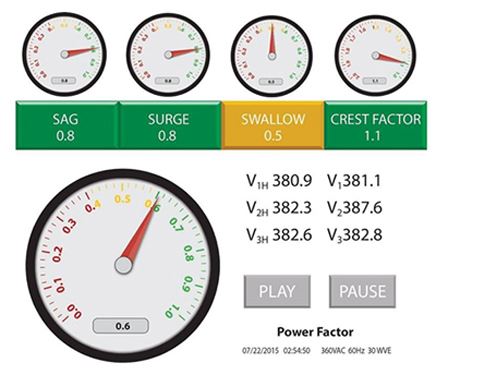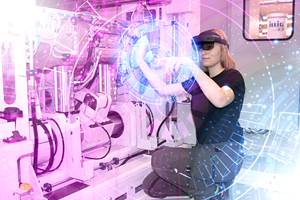‘Wearable’ Machine Sensors Extended to Power Factor & Retrofits
As is often the case with a new technology, customers are dictating how predictive-maintenance sensors will be applied and where they might be headed next.
Shown at NPE2015 for the first time, new technology that uses wireless Cloud-computing sensors to analyze and predict equipment failure garnered an overwhelming, and at times, surprising, response (see February and May Close Ups). In short, almost everyone who sat through the demo of new predictive-maintenance technology at Novatec’s booth was interested, but not everyone was as keen to purchase new auxiliary equipment to avail themselves of it.
“We had so many people at our booth who said, ‘Well gee, I have all these problems you’re describing, but what can I do about them?’” says Conrad Bessemer, president of Baltimore-based Novatec. “‘You can’t help me other than I’m going to have to replace all my equipment.’”
To support processors interested in the technology but who might not be in the market for all-new auxiliaries, Novatec and its partner on the project, Prophecy Sensorlytics, Columbia, Md., have developed a retrofittable product that can be added to machinery already in the field, including non-Novatec products.
Novatec says the new ESP Sensorlytics will detect specific issues that are typical with vacuum pumps, including problems like worn bearings, which can cause a heaving friction and lead to overheating of the motor, as well as poor oil viscosity or unsafe pump operation. The so-called Pump Lite does this in the same manner as the original Prophecy technology being deployed on new Novatec equipment: by detecting anomalies in vibration and magnetic field.
Where it will differ from the technology shown at NPE2015 is the use of what the company calls self-learning and reinforced learning. At its R&D lab, Novatec has studied its own pumps and dryers, learning about their failure modes and feeding that information into Prophecy’s algorithm so that it knows what a low-oil vibration feels like, for instance.
To provide the same predictive maintenance for equipment made by other OEMs, which has not been put through the same testing, the new ESP Sensorlytics will apply a Cloud-based “deep learning” technique to understand the physics of the maintenance condition automatically. The software will also have a field-learning mode in which a user will be able to set the maintenance gauge according to his/her best experience. In the self-learning mode, Novatec said the system tries to fit data with physics of a known anomaly; while in the reinforced-learning mode, a user trains the system on what to show on the Predictive Maintenance Gauge.
Novatec notes that an ESP Sensorlytics beta version will be available around November or December for selected customers. The company’s ESP Sensorlytics Plus, which is a full pump predictive-maintenance system will be available on the new Novatec Silencer and VPDB positive-displacement vacuum pumps. With ESP Sensorlytics Plus, users can check filter condition, oil level, and belt tension in addition to bearing condition, oil viscosity, and unsafe operation.
Prophecy Sensorlytics likes to refer to its technology as “machine-wearable” by analogy with wearable pulse monitors for athletes—and also as a way of emphasizing that its sensors are externally mounted (via magnets) and their built-in Internet communications do not have to be tied into the machine controls.
Novatec says it will supply an installation kit of machine-wearable sensors and a data hub, allowing the user to access the predictive-maintenance condition of five pumps. In time, the company said that limit will be raised to 20 pumps and will cover a distance of 300 ft. Pump Prime will automatically establish baselines on new pumps, so anomalies will be clearly displayed when operational issues develop in the future.
POWER, AIR, WATER
In the course of developing Prophecy, and in the time since its launch, Novatec and Sensorlytics have honed in on specific areas to apply the technology. “Our focus is really on power, air, and water,” Bessemer explains, “and if you think about it, that’s what drives or complements most machinery. Any machine that uses those types of processes is really eligible for Prophecy.”
One of the factors the company tested as it developed its Prophecy sensors was power—both the quality of incoming power to the equipment and the equipment’s power consumption. Unimpressed by the current power-meter offerings and knowing that inconsistent and/or poor-quality power supply are a major source of maintenance for equipment, Novatec and Sensorlytics decided to create their own power-quality monitoring system using what it calls power-factor sensors.
According to Novatec, power quality has become a major industrial issue with the widespread use of sensitive electronic equipment, making manufacturers much more aware of power anomalies. Varying internal loads within the plants from sources such as variable-speed drives, microprocessor-based devices, lighting, and battery chargers also contribute to the quality of electric power in a circuit, causing poor power factor, harmonics, and power-quality events such as sags, swells, and transients.
Novatec noted that plastics processors today can either apply power-factor sensors connected to an industrial bus network, with data analyzed by licensed software, or they can use a stand-alone power meter to record voltage and current.
Novatec and Sensorlytics will offer a third option: a power-quality monitoring system that uses an Internet-based architecture for 24-7 power-quality tracking of all the machines in a factory.
By applying sensor-on-chip (SoC) technology, plus a wireless network and a new distributed computational technique, the company says it has been able to reduce the cost of such systems by 90%. Whereas in the past, power-quality tracking would require an industrial bus system, additional I/O, and several layers of additional software licensing, Novatec says Prophecy power-quality monitoring systems use a single silicon chip, open-source networking, and Cloud-based software to keep costs within the reach of small manufacturers like plastics processors.
With Prophecy, power-factor sensors provide automatic 24-7 tracking of all power issues, including harmonic distortion, swallow, sag, surge, interruptions, and power factor. No PLCs or additional equipment are required; processors just install snap-split-core sensors from Prophecy in the three-phase lines going into their machines, and then a Prophecy data-hub will collect all the data from the sensors in a wireless network.
That data will be pushed to a Cloud server, from which a processor will be able get a summary of all the issues in all the three phase-lines going into individual machines in real time. This data will be available on any smart phone or tablet registered with the application.
“The electrical power-factor instrument industry is well established,” Bessemer notes, “but I would guess that fewer than 10% of our customers have such an instrument, because it can cost $5000 to $15,000 by the time you buy all the software and everything else to do it effectively, and maybe you still need an electrical engineer to sort out for you what’s being recorded. Our intention is to extend the market to those who have previously been unable to take advantage of that type of technology, and the only way you do that is disrupting on prices.”
THE SILENT PRODUCTIVITY KILLER
In the western world, high-quality electrical power, much like clean drinking water, is assumed, but perhaps it shouldn’t be. Says Bessemer, “With power quality, the challenge is to explain it to an industry that really doesn’t understand power, because you make this assumption that we’ll just plug something in and instantly everything’s going to be wonderful. The power somehow gets there; and it’s always going to be the same power and life is good. Well life isn’t good. You’re having all sorts of problems, as we see all the time as an equipment manufacturer. Someone calls us and says, ‘My controller stopped working and I have to reset it. How did that happen?’ It’s usually power-related.”
In addition to tracking electrical consumption, the system will continuously track power-quality metrics like sag, surge, swallow, and crest factor, helping processors better understand a process variable with a huge impact on their operations.
Related Content
Thermoforming PCR: An Equipment Supplier’s Pointers
Thermoforming PCR is not radically different from forming virgin, but variation in recycled materials can require extra care to get a consistent end result. Start by examining every aspect of the process from the sheet (and extrusion process if run inline) to the final trim.
Read MoreUS Merchants Makes its Mark in Injection Molding
In less than a decade in injection molding, US Merchants has acquired hundreds of machines spread across facilities in California, Texas, Virginia and Arizona, with even more growth coming.
Read MoreEnhanced Digitization in Thermoforming
Illig’s Easy product family includes the newly developed Human Machine Interface, Illig Easy Touch.
Read MoreOMV Technologies Gets New CEO
Kooper brings 33 years of experience in the industrial and consumer packaging industries to OMV--the closed-loop, turnkey, inline extrusion, thermoforming and tooling systems manufacturer.
Read MoreRead Next
Advanced Recycling: Beyond Pyrolysis
Consumer-product brand owners increasingly see advanced chemical recycling as a necessary complement to mechanical recycling if they are to meet ambitious goals for a circular economy in the next decade. Dozens of technology providers are developing new technologies to overcome the limitations of existing pyrolysis methods and to commercialize various alternative approaches to chemical recycling of plastics.
Read MoreHow Polymer Melts in Single-Screw Extruders
Understanding how polymer melts in a single-screw extruder could help you optimize your screw design to eliminate defect-causing solid polymer fragments.
Read MoreUnderstanding Melting in Single-Screw Extruders
You can better visualize the melting process by “flipping” the observation point so that the barrel appears to be turning clockwise around a stationary screw.
Read More
































